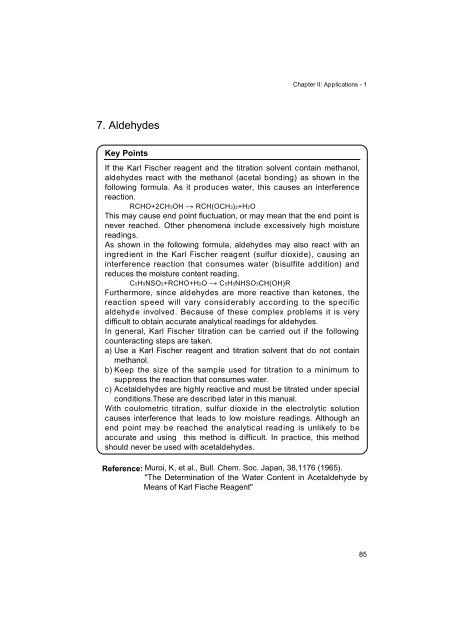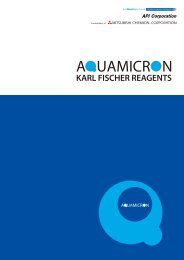Development of Karl Fischer Reagents
Development of Karl Fischer Reagents
Development of Karl Fischer Reagents
Create successful ePaper yourself
Turn your PDF publications into a flip-book with our unique Google optimized e-Paper software.
7. Aldehydes<br />
Key Points<br />
Chapter II: Applications - 1<br />
If the <strong>Karl</strong> <strong>Fischer</strong> reagent and the titration solvent contain methanol,<br />
aldehydes react with the methanol (acetal bonding) as shown in the<br />
following formula. As it produces water, this causes an interference<br />
reaction.<br />
RCHO+2CH3OH � RCH(OCH3)2+H2O<br />
This may cause end point fluctuation, or may mean that the end point is<br />
never reached. Other phenomena include excessively high moisture<br />
readings.<br />
As shown in the following formula, aldehydes may also react with an<br />
ingredient in the <strong>Karl</strong> <strong>Fischer</strong> reagent (sulfur dioxide), causing an<br />
interference reaction that consumes water (bisulfite addition) and<br />
reduces the moisture content reading.<br />
C5H5NSO2+RCHO+H2O � C5H5NHSO3CH(OH)R<br />
Furthermore, since aldehydes are more reactive than ketones, the<br />
reaction speed will vary considerably according to the specific<br />
aldehyde involved. Because <strong>of</strong> these complex problems it is very<br />
difficult to obtain accurate analytical readings for aldehydes.<br />
In general, <strong>Karl</strong> <strong>Fischer</strong> titration can be carried out if the following<br />
counteracting steps are taken.<br />
a) Use a <strong>Karl</strong> <strong>Fischer</strong> reagent and titration solvent that do not contain<br />
methanol.<br />
b) Keep the size <strong>of</strong> the sample used for titration to a minimum to<br />
suppress the reaction that consumes water.<br />
c) Acetaldehydes are highly reactive and must be titrated under special<br />
conditions.These are described later in this manual.<br />
With coulometric titration, sulfur dioxide in the electrolytic solution<br />
causes interference that leads to low moisture readings. Although an<br />
end point may be reached the analytical reading is unlikely to be<br />
accurate and using this method is difficult. In practice, this method<br />
should never be used with acetaldehydes.<br />
Reference:<br />
Muroi, K, et al., Bull. Chem. Soc. Japan, 38,1176 (1965).<br />
"The Determination <strong>of</strong> the Water Content in Acetaldehyde by<br />
Means <strong>of</strong> <strong>Karl</strong> Fische Reagent"<br />
85




